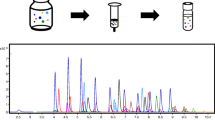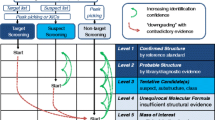Abstract
With the increasing demand on pesticide residue laboratories to increase their scope of analysis, high-resolution accurate mass (HRAM) systems have found increasing popularity in this area. The systems have the advantage of much more reliable confirmation as high resolution increases the ability to distinguish between masses which are close together and the mass accuracy achieved limits the number of structural formulae. To date, much of the work involving these systems has revolved around developing screening methods and little has been done on use of these systems for quantitative methods. Here we describe the development and validation of a quantitative method for the analysis of 167 pesticide residues and polychlorinated biphenyls (PCBs) in samples of fruit and vegetables according to the protocol described in EU SANTE guidance document. The determination method involves analysis using a GC QExactive orbitrap in full scan mode using EI. The samples were then extracted using the standard mini-Luke method. After extraction with acetone/dichloromethane/petroleum ether 40–60 °C, a solvent exchange into ethyl acetate is carried out. Recovery work was carried out in cucumber, lemon and broccoli representing high water content, high acid content and high chlorophyll content commodity groups. The results show that the default MRL of 10 ppb can be achieved for more than 93% of the pesticides studied. Mass accuracy, ion ratio and matrix effect studies show that the method is robust and provides a viable alternative to triple quadrupole mass spectrometer systems for the quantification of pesticide residues in fruit and vegetable samples.








Similar content being viewed by others
References
Fussell RJ, Hetmanski MT, Colyer A, Caldow M, Smith F. Assessment of the stability of pesticides during the cryogenic processing of fruits and vegetables. Food Addit Contam. 2007;24(11):1247–56.
Lehotay SJ, Michlig N, Lightfield AR. Assessment of test portion sizes after sample comminution with liquid nitrogen in an improved high-throughput method for analysis of pesticide residues in fruits and vegetables. J Agric Food Chem. 2020;68(5):1468.
Anastassiades M, Lehotay S, Stajnbaher SJ, Schenck FJ. Fast and easy multi-residue method employing acetonitrile/partitioning and “dispersive solid phase extraction” for the determination of pesticide residues in produce. JAOAC Int. 2003;86(2):412–31.
Luke MA, Froberg JE, Masumoto HT. Extraction and clean-up of organochlorine, organophosphate, organonitrogen and hydrocarbon pesticidesin produce for determination by gas-liquid chromatography. J Assoc Off Anal Chem. 1975;58(5):1020–6.
Analytical methods for pesticide residues in foodstuffs, 6th ed, Ministry of Public Health, Welfare and Sport, The Netherlands.
Lozano A, Kiiedrowska B, Scholten J, de Kroon M, de Kok A, Fernandez-Alba AR. Miniaturisation and optimization of the Dutch mini-Luke extraction method for implementation in the routine multi-residue analysis of pesticides in fruits and vegetables. Food Chem. 2016;192:668–81.
Jansson C, Pihlstrom T, Osterdahl BG, Markides KE. A new multi-residue method for analysis of pesticide residues in fruit and vegetables using liquid chromatography with tandem mass spectrometric detection. J Chromatogr A. 2004;1023(1):93–104.
Klein J, Alder L. Applicability of gradient liquid chromatography with tandem mass spectrometry to the simultaneous screening of about 100 pesticides in crops. J AOAC Int. 2003;86(5):1015–37.
Lehotay SJ, Son KA, Kwon H, Koesukwiwat U, Mastovska K, Hoh E, et al. Comparison of QuEChERS sample preparation methods for the analysis of pesticides in fruits and vegetables. Chromatogr A. 2010;1217(16):2548–60.
Lehotay S, Anastassiades M, Majors R. The QuEChERs revolution. LC GC Europe. 2010;23.
Zomer P, Mol HGJ. Simultaneous quantitative determination, identification and qualitative screening in fruits and vegetables using LC-Q-OrbitrapTM MS. Food Addit Contam. 2015:1629–36.
Rajski L, del Mar Gomes Ramos M, Fernandez-Alba AR. Evaluation of MS2 workflows in LC-Q-Orbitrap for pesticide multi-residue methods in fruit and vegetables. Anal Bioanal Chem. 2017;409:5389–400.
Ferrer C, Malato O, Agüera A, Fernández-Alba A. Application of HPLC-TOF-MS and HPLC-QTOF-MS/MS for pesticide residues analysis in fruit and vegetable matrices. Compr Anal Chem. 2012;58:1–60.
Rajski L, Martinez-Bueno MJ, Ferrer C, Fernandez-Alba AR. LC-ESI-QOrbitrap™ MS/MS within pesticide residue analysis in fruits and vegetables. TrAC Trends Anal Chem. 2019;118:587596.
Ucles S, Ucles A, Lozano A, Martinez-Bueno MJ, Fernandez-Alba AR. Shifting the paradigm in gas chromatography mass-spectrometry pesticide analysis using high resolution accurate mass spectrometry. J Chromatogr A. 2017;1501:107–16.
Mol HG, Tienstra M, Zomer P. Evaluation of gas chromatography - electron ionization - full scan high resolution Orbitrap mass spectrometry for pesticide residue analysis. Anal Chim Acta. 2016;935:161–72.
Erecius Poulsen M, Strange Herrmann S, Hakme E (2017) Screening validation report. EURL Website. https://www.eurl-pesticides.eu/userfiles/file/(S7)%20Appendix3_Validation%20report_screening_GC-QTOF%20screening%20report%207.pdf.
Wang J, Chow JW, Leung D, Chang J, Li M. Non-target data acquisition for target analysis (nDATA) of 845 pesticide residues in fruits and vegetables using UHPLC/ESI Q-Orbitrap. Anal Bioanal Chem. 2019;411(17):1421–31.
Wang J, Chow W, Chang J, Wong JW. Development and validation of a qualitative method for target screening of 448 pesticide residues in fruits and vegetables using UHPLC/ESI Q-Orbitrap based on data-independent acquisition and compound database. J Agric Food Chem. 2017;66(2):473–93.
Mol HG, Zomer P, DE Koning M. Qualitative aspects and validation of a screening method for pesticides in vegetables and fruits based on liquid chromatography coupled to full scan high resolution (Orbitrap) mass spectrometry. Anal Bioanal Chem. 2012;403(10):2891–908.
Alder L, Steinborn A, Bergelt S. Suitability of an Orbitrap mass spectrometer for the screening of pesticide residues in extract of fruits and vegetables. J AOAC Int. 2011;94:1661–73.
Rajski Ł, Ramos MM, Fernández-Alba A. Application of LC-time-of-flight and Orbitrap-MS/MS for pesticide residues in fruits and vegetables. 2016. https://doi.org/10.1016/bs.coac.2016.02.001.
Guidance document on analytical quality control and method validation procedures for pesticide residues and analysis in food and feed. SANTE/11813/2017, EURL website. https://ec.europa.eu/food/sites/food/files/plant/docs/pesticides_mrl_guidelines_wrkdoc_2017-11813.pdf.
Peruga A, Barreda M, Beltrán J, Hernández F. A robust GC-MS/MS method for the determination of chlorothalonil in fruits and vegetables. Food Addit Contam A. 2013;30(2):298–307.
Foreman WT, Paul M. Gates matrix-enhanced degradation of p,p‘-DDT during gas chromatographic analysis: a consideration. Environ Sci Technol. 1997;31(3):905–10.
Author information
Authors and Affiliations
Corresponding author
Ethics declarations
Conflict of interest
The authors declare that they have no conflict of interest.
Additional information
Publisher’s note
Springer Nature remains neutral with regard to jurisdictional claims in published maps and institutional affiliations.
Electronic supplementary material
ESM 1
(PDF 5.22 kb)
Rights and permissions
About this article
Cite this article
Garvey, J., Walsh, T., Devaney, E. et al. Multi-residue analysis of pesticide residues and polychlorinated biphenyls in fruit and vegetables using orbital ion trap high-resolution accurate mass spectrometry. Anal Bioanal Chem 412, 7113–7121 (2020). https://doi.org/10.1007/s00216-020-02844-w
Received:
Revised:
Accepted:
Published:
Issue Date:
DOI: https://doi.org/10.1007/s00216-020-02844-w




